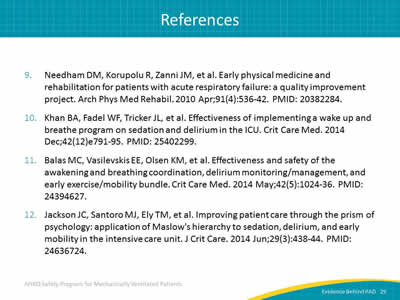Evidence Behind Pain, Agitation, and Delirium: Assessments and Sedation Management: Facilitator Guide
AHRQ Safety Program for Mechanically Ventilated Patients
Slide 1: Evidence Behind Pain, Agitation, and Delirium: Assessments and Sedation Management
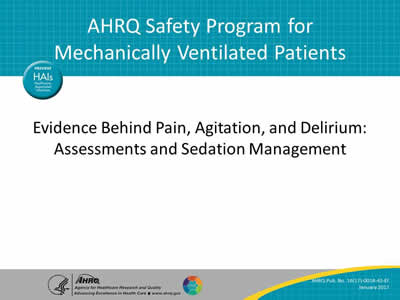
Say:
In this module, you will learn about the evidence behind pain, agitation, and delirium. You will also learn about delirium assessments and sedation management.
Slide 2: Learning Objectives
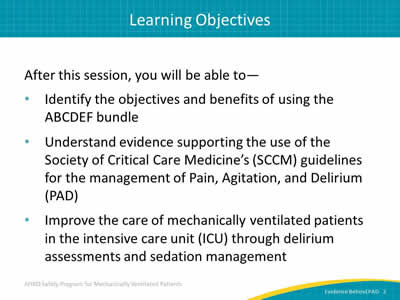
Say:
After this session, you will be able to identify the objectives and benefits of using the ABCDEF bundle to understand evidence supporting the use of the Society of Critical Care Medicine’s or SCCM’s guidelines for the management of pain, agitation, and delirium, PAD, as well as improve the care of mechanically ventilated patients in the intensive care unit or ICU through delirium assessments and sedation management.
Slide 3: Pain, Agitation, and Delirium
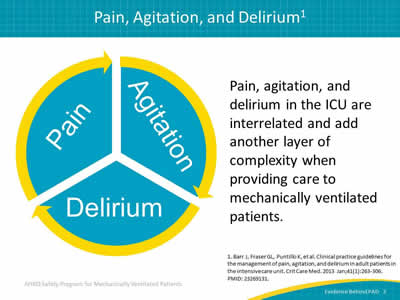
Say:
Pain, agitation, and delirium in the ICU are interrelated and add another layer of complexity when providing care to mechanically ventilated patients. Understanding how to manage sedation can help interrupt the cycle of these three complications.
This slide demonstrates the wheel of pain, agitation, and delirium as a cycle.
Slide 4: Pain, Agitation, and Delirium
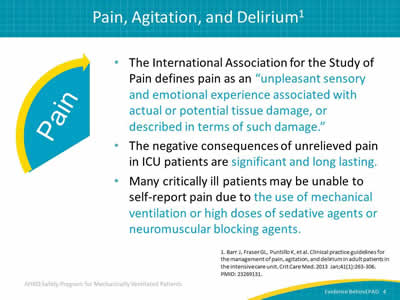
Say:
The International Association for the Study of Pain defines pain as an "unpleasant sensory and emotional experience associated with actual or potential tissue damage, or described in terms of such damage." The negative consequences of unrelieved pain in ICU patients are significant and long lasting. Many critically ill patients may be unable to self-report pain due to the use of mechanical ventilation or high doses of sedative agents or neuromuscular blocking agents.
Slide 5: Pain, Agitation, and Delirium
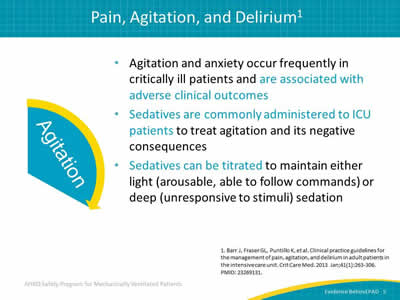
Say:
Agitation and anxiety occur frequently in critically ill patients and are associated with adverse clinical outcomes. Sedatives are commonly administered to ICU patients to treat agitation and its negative consequences. Sedatives can be titrated to maintain either light sedation, in which the patient is still able to be aroused and follow commands, or deep sedation, in which the patient is unresponsive to stimuli.
Slide 6: Pain, Agitation, and Delirium
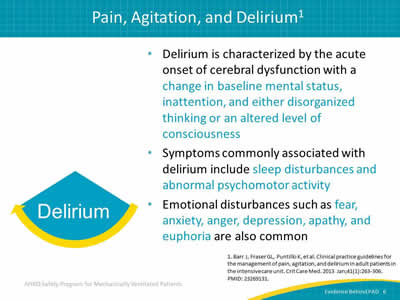
Say:
Delirium is characterized by the acute onset of cerebral dysfunction with a change in baseline mental status, inattention, and either disorganized thinking or an altered level of consciousness. Symptoms commonly associated with delirium include sleep disturbances and abnormal psychomotor activity. Emotional disturbances such as fear, anxiety, anger, depression, apathy, and euphoria are also common.
Slide 7: ABCDEF Bundle Checklist
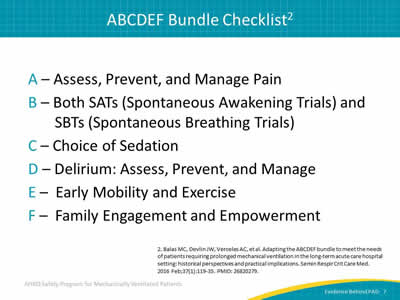
Say:
This bundle is the result of several individual studies each analyzing different factors, such as pain, spontaneous awakening trials or SATs, spontaneous breathing trials or SBTs, delirium, choice of drug, and early mobility. This slide defines the ABCDEF bundle acronym. "A" represents the assessment, prevention, and management of pain. "B" represents both SATs and SBTs. "C" represents the choice of sedation. "D" represents delirium to be assessed, prevented, and managed. "E" represents the early mobility and exercise of patients. Finally, "F" represents family engagement and empowerment.
Slide 8: ABCDEF Bundle Objectives
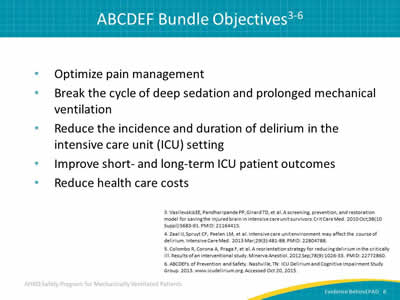
Say:
The objectives of the ABCDEF bundle are to optimize pain management, break the cycle of deep sedation and prolonged mechanical ventilation, reduce the incidence and duration of delirium in the ICU setting, improve short- and long-term ICU patient outcomes, and reduce health care costs by reducing the average length of stay in the ICU and within the hospital.
Slide 9: ABCDEF Implementation Success: Meta-Analysis
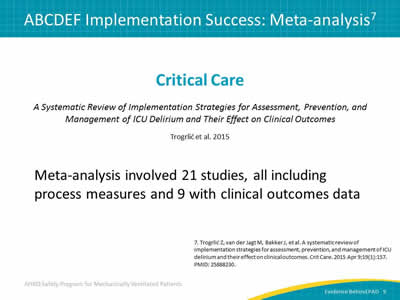
Say:
A meta-analysis was taken of 21 studies, all including process measures and 9 specifically with clinical outcomes data.
Slide 10: ABCDEF Implementation Success: Meta-Analysis
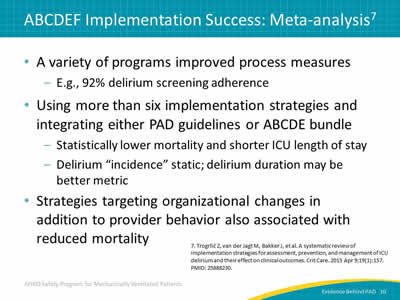
Say:
A variety of programs have improved process measures using the ABCDEF bundle, such as achieving a 92 percent delirium screening adherence. Mobility has increased as well. When multidisciplinary teams engage patients in physical and occupational therapy, the results are more patients getting out of bed, sitting on the side of the bed, and even moving to sit in chairs.
As important as the ABCDEF bundle is, implementing structural and organizational changes that improve standard provider behaviors are vital to achieving higher success rates, ensuring compliance, and establishing long-term sustainable change. The Institute for Healthcare Improvement instructs in the Journal of Quality and Patient Safety that certain environment changes require human beings to modify their behavior. Human factors are such an important piece to achieving sustainable change. As a result, you should give feedback regularly, provide ongoing education, and build a strong will through seeing work in action with your staff.
According to statistics, using more than six implementation strategies and integrating either PAD guidelines or the ABCDEF bundle lowers mortality and shortens ICU length of stay. Delirium "incidence" remains static, and so delirium duration may be a better metric.
Slide 11: Keystone’s ABCDE Bundle Collaborative Results
![51 hospitals in Michigan’s Keystone ICU initiative. Those implementing combined SATs and delirium screening were 3.5 times as likely to exercise ventilated patients. Incomplete or nonsequential bundle implementation yielded lower success rates. Authors concluded that with regard to the ABCDE bundle, '[T]he whole truly is greater than the sum of its parts.'](/sites/default/files/wysiwyg/professionals/quality-patient-safety/hais/tools/mvp/modules/technical/painmgmt/painmgmt-slide11.jpg)
Say:
In this study of 51 hospitals involved in Michigan’s Keystone ICU initiative, those implementing combined SATs and delirium screening were 3.5 times as likely to exercise ventilated patients. Those implementing incomplete or nonsequential bundles yielded lower success rates. Authors have written that with regard to the ABDCE bundle, this initiative has shown "another layer of evidence [that] the whole truly is greater than the sum of its individual parts."
Slide 12: 2013 Society of Critical Care Medicine PAD Guidelines
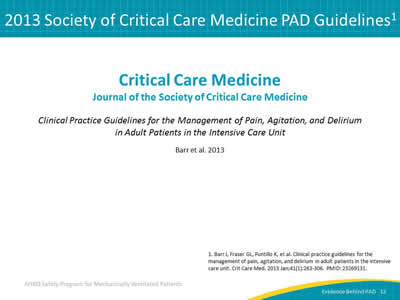
Say:
Now we will discuss the 2013 SCCM PAD guidelines for adult patients in the ICU.
Slide 13: 2013 Society of Critical Care Medicine PAD Guidelines
![1. Establish an overarching and standardized approach to daily patient management in the intensive care unit by implementing 2013 PAD Guidelines. 2. Assess and treat pain first. 3. Avoid benzodiazepines in most patients. 4. Either interrupt sedation daily OR target light sedation: Avoid deep sedation (Richmond Agitation-Sedation Scale [RASS] score of -4/-5) as it appears harmful; instead, target awake or alert.](/sites/default/files/wysiwyg/professionals/quality-patient-safety/hais/tools/mvp/modules/technical/painmgmt/painmgmt-slide13.jpg)
Say:
The 2013 PAD guidelines were developed by a task force convened by SCCM to replace the previous guidelines from 2003. The 2013 PAD guidelines were established based on a thorough review of over 19,000 references related to pain and analgesia, agitation and sedation, delirium, and related clinical outcomes in adult ICU patients.
Using these guidelines, you should establish an overarching and standardized approach to daily patient management in the ICU. Be sure to assess and treat pain first and avoid benzodiazepines in most patients. Choose to either interrupt sedation daily or target light sedation. Deep sedation, as determined by a score of -4 or -5 on the Richmond Agitation-Sedation Scale, should be avoided as deep sedation has been shown to be harmful.
Slide 14: 2013 Society of Critical Care Medicine PAD Guidelines
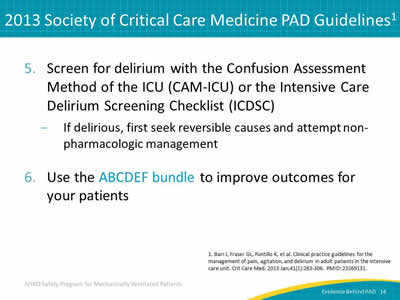
Say:
Screen for delirium with the Confusion Assessment Method of the ICU (CAM-ICU) or the Intensive Care Delirium Screening Checklist (ICDSC). If the patient is delirious, first seek reversible causes and attempt nonpharmacologic management. Finally, the PAD guidelines recommend use of the ABCDEF bundle to improve outcomes for your patients.
Slide 15: SCCM: PAD Treatment of Delirium Recommendations
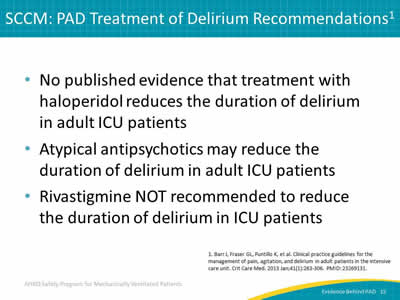
Say:
While there is no published evidence that treatment with haloperidol actually stifles delirium, certain atypical antipsychotics may reduce the duration of delirium in adult ICU patients. However, rivastigmine isn’t recommended.
Slide 16: Delirium Screening in the ICU
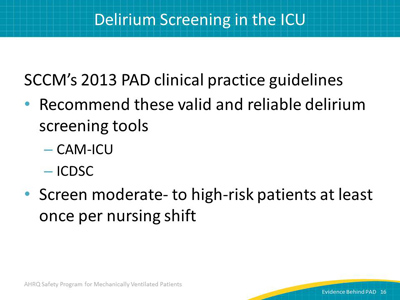
Say:
The 2013 SCCM PAD guidelines recommend such valid and reliable delirium screening tools as the CAM-ICU and the ICDSC. Using these tools, you should screen moderate- to high-risk patients at least once per nursing shift.
Slide 17: Don’t Forget About Dr. Dre
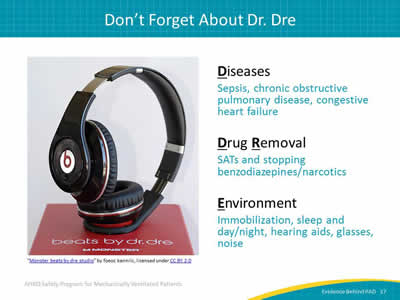
Say:
When a patient is diagnosed with delirium, the main concern tends to be over what drug they should be given. The real issues, however, are the environmental disease-related causes that need to be prevented and the drugs that need to be removed, such as GABAergics. A pneumonic tool called Dr. DRE is used to diagnose delirium. Remember the tool by thinking of rapper, record producer, and entrepreneur Dr. Dre—headphones sold by the company he co-founded, Beats by Dr. Dre, are shown here. This slide defines the Dr. DRE acronym. "D" represents diseases such as sepsis, chronic obstructive pulmonary disease, hypoxemia, and congestive heart failure. "DR" represents drug removal, which is achieved using SATs and by stopping the use of benzodiazepines and narcotics. "E" represents the environment encompassing patient immobilization. The constant activity in acute care units can lead to disturbed sleep/wake cycles and circadian rhythms. Keep in mind some of the things you can do to make the hospital environment less stressful, including providing hearing aids or glasses for the patient, keeping the patient unrestrained, and ensuring tolerable noise levels around the unit.
Slide 18: Johns Hopkins Medicine Quality Improvement (QI) Project

Say:
This Johns Hopkins Medicine quality improvement or QI project was mainly organized toward reducing benzodiazepine exposure while subsequent Johns Hopkins QI projects have been organized toward improving sleep. This table represents the probability of delirium over time after using a medication protocol to reduce benzodiazepine exposure. As this table depicts, less benzodiazepines and more mobility reduces patient delirium over time.
Slide 19: Wake Up and Breathe Program Results: Indiana University
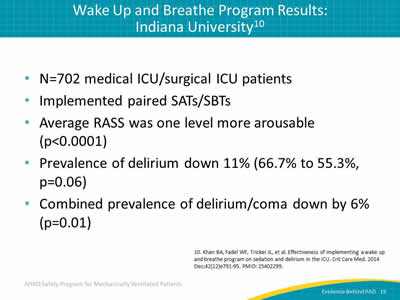
Say:
In terms of modifying the environment or modifying drug delivery, each of these studies culminated in improved clinical outcomes, such as reductions in delirium. At Indiana University, there was a study involving 702 medical and surgical ICU patients that underwent paired SATs and SBTs. This study used a bundled approach that achieved an average RASS that was one level more arousable, lowered the combined prevalence of delirium and coma by 6 percent, and lowered the prevalence of delirium itself by 11 percent.
Slide 20: Efficacy and Safety
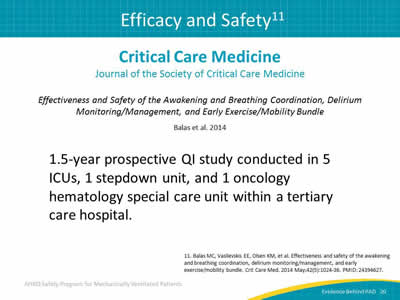
Say:
We will now discuss the effectiveness and safety of awakening and breathing coordination, delirium monitoring and management, and the early exercise and mobility bundle used in a 1.5-year prospective QI project conducted in five adult ICUs, one stepdown unit, and one oncology hematology special care unit within a tertiary-care hospital. The study looked at a total of 296 patients, of which 187 were mechanically ventilated. Data was collected pre- and post-QI implementation.
Slide 21: Efficacy and Safety: Ventilator-Free Days
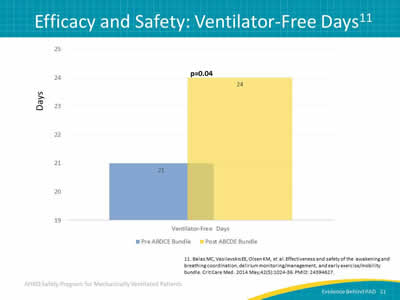
Say:
For the cohort of mechanically ventilated patients, this study examined the association between implementation of the ABCDE bundle and ventilator-free days.
This bar graph demonstrates an increase of 4 ventilator-free days after using the ABCDE bundle compared with procedures prior to using the bundle.
Slide 22: Efficacy and Safety: Delirium Results
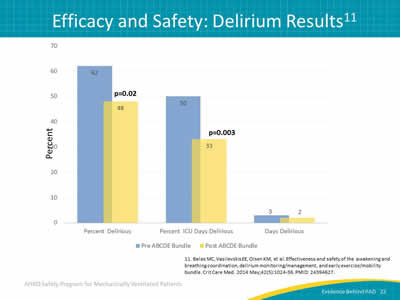
Say:
The post-QI implementation of the ABCDE bundle was applied to mechanically ventilated patients as well as non-ventilated patients. This bar graph demonstrates a decrease in days delirious, the percent of days delirious in the ICU, and the overall percentage of delirium for all participants after using the ABCDE bundle compared with procedures prior to using the bundle.
Slide 23: Efficacy and Safety: Early Mobility Results
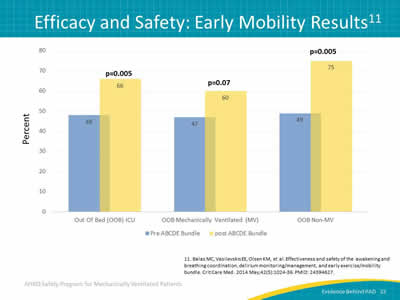
Say:
This bar graph demonstrates an increase in the percentages of patients out of bed in the ICU, out-of-bed patients who are mechanically ventilated, and out-of-bed patients who are not mechanically ventilated after using the ABCDE bundle compared with procedures prior to using the bundle.
Slide 24: 28-Day Mortality Results
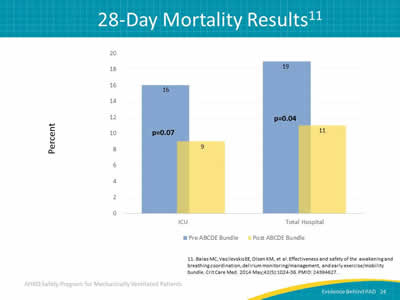
Say:
This bar graph demonstrates a decrease in the percentage of mortality in the ICU and the total percentage of mortality in the hospital after using the ABCDE bundle compared with procedures prior to using the bundle. This is a significant discovery, as we now know we can improve time alive and off of ventilators using this bundle.
Slide 25: Maslow’s Hierarchy of Needs in Critical Care
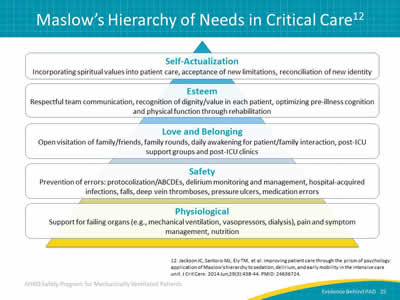
Say:
In 1943, psychologist Abraham Maslow proposed his theory of a hierarchy of human needs. Presented as a pyramid, one must satisfy the lower level, basic needs before progressing to meet higher level needs.
In 2014, Jackson et al. adapted the concept of Maslow’s hierarchy of needs to illustrate the needs of patients in the critical care setting. The base of the pyramid is physiological, dealing with support for failing organs such as using mechanical ventilation, vasopressors, and dialysis, pain and symptom management, and nutrition.
The next level deals with safety through protocolization, the ABCDEF bundle, and delirium monitoring and management for the prevention of such errors as hospital-acquired infections, falls, deep vein thromboses, pressure ulcers, and medication errors.
Love and belonging form the next tier, which includes the open visitation of family and friends, family rounds, daily awakening of the patient for family interaction, post-ICU support groups, and post-ICU clinics. It’s more dignified to allow patients to communicate on their own with their family and health care providers.
Esteem, above love and belonging, involves respectful team communication, recognition of the dignity and value of each patient, and optimizing pre-illness cognition and physical function through rehabilitation.
The highest point of Maslow’s hierarchical pyramid is self-actualization, which incorporates spiritual values into patient care, breeds acceptance of new limitations, and allows the patient to reconcile with a new identity. Light sedation for patients that are awake is as much a physical, spiritual, and mental element as it is about health. It’s important to be considerate of the patient’s mind and spirit so that the patient can be cared for in his or her entirety.
Slide 26: Questions?

Ask:
Are there any questions?
Slide 27: References
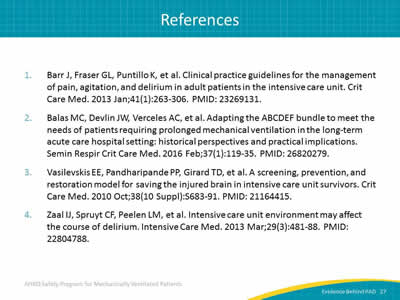
Slide 28: References
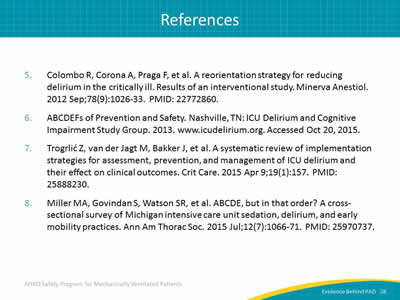
Slide 29: References
